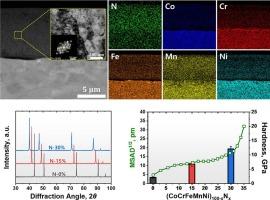研究(CoCrFeMnNi)100-xNx高熵氮化陶瓷的纳米力学特性:一种综合实验和计算方法
IF 5.5
2区 材料科学
Q1 MATERIALS SCIENCE, CHARACTERIZATION & TESTING
引用次数: 0
摘要
高熵陶瓷(HECs)由于其优异的机械和热性能,近年来作为一种有前途的极端环境涂层材料受到了广泛的关注。尽管对hec进行了大量研究,但基于CoCrFeMnNi等原子组成(也称为Cantor合金,最具代表性的高熵合金(HEA)体系之一)表征其内在力学性能的研究有限。这种间隙的产生是因为碳和氮亲和的Cr元素倾向于形成碳化铬或氮化铬,由于析出物或初始裂纹的存在而干扰其固有性能的评估。在这项研究中,我们成功地在微米尺度上合成了无裂纹和无沉淀晶体(CoCrFeMnNi)85N15和(CoCrFeMnNi)70N30 HECs。通过纳米硬度测试评估了它们的力学性能,与CoCrFeMnNi HEA相比,它们的纳米硬度值更高。此外,利用密度泛函理论(DFT)计算分析了氮原子如何融入到CoCrFeMnNi金属晶格中,以及向HECs的转化如何提高了CoCrFeMnNi金属晶格的力学性能。基于cocrfemnni的晶体HEC的成功制造策略,对其微观结构和内在力学性能的分析,以及通过DFT计算对其潜在机制的探索,将为各种HEC系统提供从基础知识到实际应用的创新视角。本文章由计算机程序翻译,如有差异,请以英文原文为准。

Exploring nanomechanical characteristics of (CoCrFeMnNi)100-xNx high-entropy nitride ceramics: An integrated experimental and computational approach
High-entropy ceramics (HECs) have recently gained significant attention as promising coating materials for extreme environments due to their excellent mechanical and thermal properties. Despite numerous studies on HECs, there is limited research characterizing the intrinsic mechanical properties based on CoCrFeMnNi equi-atomic composition, also known as the Cantor alloy, one of the most representative high-entropy alloy (HEA) system. This gap arises because the carbon- and nitrogen-affinitive Cr elements tend to form chromium carbides or chromium nitrides, which interfere with evaluations of their intrinsic properties due to the presence of precipitates or initial cracks. In this study, we successfully synthesized crack- and precipitate-free crystalline (CoCrFeMnNi)85N15 and (CoCrFeMnNi)70N30 HECs on the micrometer-scale. Their mechanical properties were evaluated through nanohardness tests, showing higher nanohardness values compared to the CoCrFeMnNi HEA. Furthermore, density functional theory (DFT) calculations were employed to analyze how nitrogen atoms are incorporated into the CoCrFeMnNi metallic lattices and how the transformation into HECs enhances the mechanical properties. The successful fabrication strategy of crystalline CoCrFeMnNi-based HECs, analyses of their microstructures and intrinsic mechanical properties, and the exploration of their underlying mechanisms through DFT calculations, will provide innovative perspectives, spanning from fundamental knowledge to practical applications, for various HEC systems.
求助全文
通过发布文献求助,成功后即可免费获取论文全文。
去求助
来源期刊

Materials Characterization
工程技术-材料科学:表征与测试
CiteScore
7.60
自引率
8.50%
发文量
746
审稿时长
36 days
期刊介绍:
Materials Characterization features original articles and state-of-the-art reviews on theoretical and practical aspects of the structure and behaviour of materials.
The Journal focuses on all characterization techniques, including all forms of microscopy (light, electron, acoustic, etc.,) and analysis (especially microanalysis and surface analytical techniques). Developments in both this wide range of techniques and their application to the quantification of the microstructure of materials are essential facets of the Journal.
The Journal provides the Materials Scientist/Engineer with up-to-date information on many types of materials with an underlying theme of explaining the behavior of materials using novel approaches. Materials covered by the journal include:
Metals & Alloys
Ceramics
Nanomaterials
Biomedical materials
Optical materials
Composites
Natural Materials.
 求助内容:
求助内容: 应助结果提醒方式:
应助结果提醒方式:


